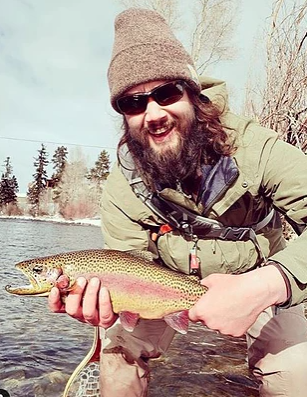
It’s winter in Colorado and the majority of the season will provide sub-freezing temperatures. While we all celebrate the unseasonably warm days and cancel plans so we can hit the river, the cold winter temperatures aren’t enough to keep the die-hards from fishing. These cold, winter days require many layers, gloves and patience when breaking ice off your lines and guides becomes a ritual. While layering up is easy and breaking ice off your rod is a necessary part of the winter fly fishing process, wearing gloves can be a challenge.
For us, the decision to wear gloves is a mental battle every time we hit the river in the winter. Why? Wearing gloves means you’re hands will be warm and “comfortable” but with that comfort you have a worse grip on the rod and line control becomes a challenge, especially if you’re wearing pull-over mittens. The trickiest part to all of this is something that many anglers either aren’t aware of, or neglect to acknowledge. Removing your gloves when handling trout is an incredibly important conservation effort that if ignored, can decrease the trout’s chance of survival. How? Trout have a protective slime on their skin that acts as their immune system, protecting them from various aquatic diseases.
During the warmer months, when gloves aren’t required, anglers are encouraged to wet their hands before handling a trout. Wetting your hands decreases the friction between your hands and the trout’s skin, which ultimately protects the integrity of their slime. Now, as you can imagine, handling a trout with your gloves, creates friction and removes the protective slime from the trout’s skin. An exception to this is gloves with a wet, neoprene palm. When the slime is removed, the trout becomes more susceptible to harmful bacteria and fungus in the water.
So, what’s the best way to fish with gloves while keeping trout safe? It easy. Wear your gloves while casting and fighting the trout to your net. Once the trout is in your net, take off both your gloves before you begin to remove the hook. Keep your gloves off while you hold the trout for your glory pic and through the release. Once you have released the trout, dry your hands off before putting them back in your gloves. Putting wet hands in your gloves won’t help your hands stay warm for the remainder of the day. Carrying an extra towel to dry your hands and keeping hand warmers in your pocket are great ways to warm your hands after dunking them in the ice-cold river. Remember, if your hands are not dry and you touch the hand warmer it will no longer function properly. A shot of whiskey is also a great hand warming tactic and one we particularly enjoy practicing.
Along with removing gloves, here are a couple bonus tips for keeping trout healthy during the winter:
- Use barbless hooks: Barbless hooks are easier to remove and allow you to quickly get the trout back in the water.
- Release trout slowly: Similar to the warm summer months, trout become increasingly stressed when the river is cold. After a long fight, the trout will be exhausted and will require some time to recover. Loosely hold the trout in the river with its head facing upstream. Gently hold the trout until you feel them pull away.
- Use a net: A net may seem unnecessary unless you’re reeling in a hog but in reality, a net will help you keep the trout in the water while removing the hook. The more the trout stays in the water, the more likely they are to recover.
